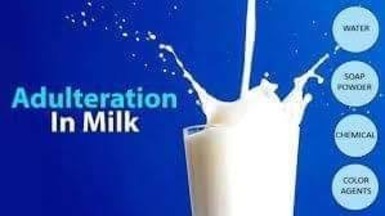The adulteration of milk with Starch, Sugar , Annato color is of not much health concerns & so detection of these are avoided here to make the article more precise. Addition of pesticides & formalin to milk may alter the physical characteristics of milk, and so small milk vendors may not dare to add those to milk. Of course large milk suppliers may dare to practice it in a minuscule manner. But our concern is to minimize this article and easy detection techniques to be used by common man for an adulteration, done by small milk vendors. The detection of the following milk adulterants are important for a common consumers:
- UREA
- BAKING POWDER
- SOAP
- HYDROGEN PEROXIDE
1. UREA
For detection of urea, a reagent called P-dimethyl amino benzal dehyde or DMAB reagent, also called Ehrlich’s reagent is used. However, now a days a paper urea milk adulteration test strip (10 strips) are available commercially which can be ordered through online.(Paper pro , GPS mats,MILK-O-STRIPS). This paper when dipped into a sample of milk, if it becomes yellow (or) green, then urea adulteration is conformed . The consumer has to follow the principles written by the company on it’s product.
DMAB or Ehrlich’s reagent is prepared by adding 10% Hydrochloric acid with 1.6% ethyl alcohol and 0.5 gram to 2.0 gram of DMAB powder (available from different chemical reagent companies like, Himedia, Sigma etc).
Now 2ml of milk +2ml of Ehrlich’s reagent, and if the color becomes clear yellow, then it is a clear case of urea adulteration. Faint yellow color or faint pink color indicates non adulteration with urea.
2. HYDROGEN PEROXIDE (H 2O2)
Potassium iodide is usually used in detecting hydrogen peroxide in milk. It is commonly available in market. Hydrogen peroxide is an oxidizing agent which is used to remove dirt. But when this chemical is ingested, it causes health hazards. Take 0.75 gram of potassium iodide in 100 ml of distilled water and this is called potassium iodide solution. Heat this solution to boiling. Then add 0.5 gram of potato starch or corn starch in 35 ml of water. Then boil it. It is called a starch solution. Now mix starch solution with potassium iodide solution and again boil it. After coming to the room temperature of both milk and the mixture solution, add few drops of the mixture solution to 5-10 ml of milk. If it is blue, indicates a presence of starch as well as hydrogen peroxide.
Inappropriate use of bicarbonate in food can lead to a condition called alkalosis, where blood becomes too alkaline. This can cause headache, nausea (vomiting), muscle pain etc.
3. SOAP
Add two drops of phenopthalin solution to 10ml of milk, priorly added with 10ml warm water. Appearance of pink color indicates presence of soap.
The simple Test
Collect 10 ml Milk in a beaker,————-shake it vigorously with a rod for 10 minutes. A bubble formation indicates presence of soap in milk.
IF no bubble——–then unadulterated. Pure milk will form only a thin layer of foam , but soap adulterated milk will form a dense froth.
Soap is a surfactant, which reduces the surface tension of the milk, thus it attracts more fat molecules towards it as soap spreads across milk. Thus there is a thick layer of foam (bubbles).
4. BAKING POWDER
5ml of milk mixed with 5ml of 95% alcohol (We can use rectified spirit, available in the medical stores for human medication cases)& Mixed well with a clean glass/plastic rod like object. If the small flakes (due to coagulation or say curdling of milk) of same size appear, it indicates presence of bicarbonates or we say the neutralizers. But if, big flakes with unequal size appers in the milk, it indicates unadulteration of the milk.

